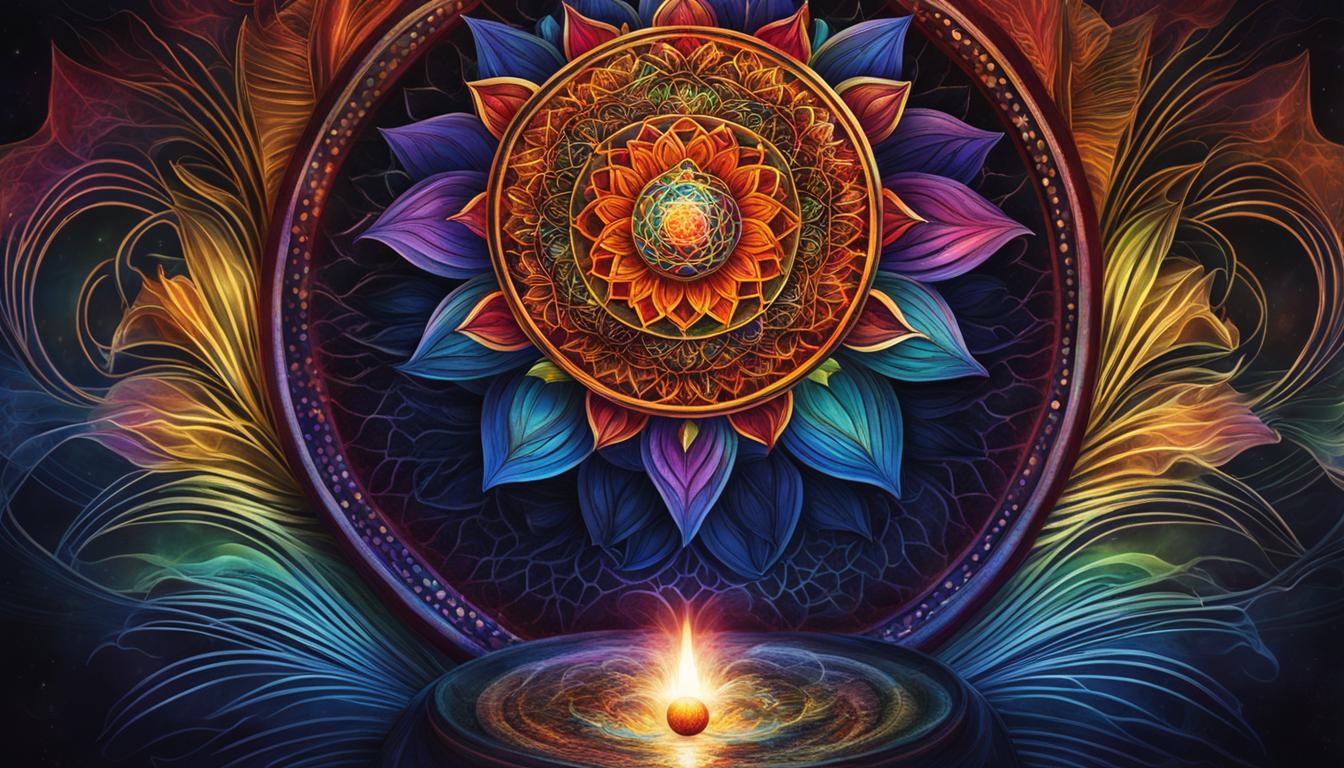Chakras are focal points of energy in the body, according to Hinduism and Buddhism. These energy centers play a significant role in various holistic medical practices, such as yoga and Ayurveda. But where do chakras actually come from? Let’s explore the origins of the chakra system and gain a deeper understanding of their history.
Key Takeaways:
- The concept of chakras originated in Hinduism and Buddhism.
- Chakras are believed to be connected through energy channels called nadi.
- The number and location of chakras may vary depending on different traditions.
- The seven-chakra system is the most well-known model in the West.
- Chakra-based therapies aim to promote balance and harmony in the chakras.
The History of Chakras
The concept of chakras has deep ancient roots in Hindu and Buddhist traditions. Ancient Indian texts known as the Vedas mention the existence of chakras, and they have been influential in shaping different Hindu and Buddhist practices over time. The exact origins of chakras are still debated, and various theories exist regarding their emergence in different cultures. Exploring the history of chakras gives us insight into their significance and how they have evolved.
In Hindu philosophy, the seven-chakra system is widely recognized. Each chakra is associated with different aspects of physical, emotional, and spiritual well-being. The seven primary chakras are Muladhara (root chakra), Svadhisthana (sacral chakra), Manipura (navel chakra), Anahata (heart chakra), Vishuddha (throat chakra), Ajna (third eye chakra), and Sahasrara (crown chakra). The number and location of chakras may vary depending on different traditions.
The history of chakras goes beyond Hinduism and Buddhism. Different cultures around the world have their own beliefs and practices surrounding chakras. For instance, ancient Egyptian and Chinese cultures also recognized energy centers similar to chakras. The understanding and interpretations of chakras have evolved over time, leading to the development of different chakra systems in various cultures.
The History of Chakras in Different Cultures:
| Culture | Chakra-like Energy Centers |
|---|---|
| Ancient Egypt | Ka and Ba |
| Traditional Chinese Medicine | Dantian and meridians |
| Mesoamerican Shamanism | Inframundo, Imix, and Ajaw |
Understanding the history of chakras allows us to appreciate their cultural significance and the diverse ways in which they have been understood and practiced throughout history. The evolving concept of chakras has fostered spiritual growth and contributed to various holistic healing practices that aim to balance and align the body, mind, and spirit.
The Seven-Chakra System
Hindu philosophy identifies seven primary chakras: Muladhara (root chakra), Svadhisthana (sacral chakra), Manipura (navel chakra), Anahata (heart chakra), Vishuddha (throat chakra), Ajna (third eye chakra), and Sahasrara (crown chakra). Each chakra is associated with different aspects of physical, emotional, and spiritual well-being. The seven-chakra system is the most well-known model in the West.
The seven chakras are believed to be vertically aligned along the spine, starting from the base and extending to the crown of the head. Each chakra is associated with specific qualities and characteristics. For example, the root chakra, located at the base of the spine, is associated with grounding, stability, and survival instincts. The crown chakra, located at the top of the head, is associated with spiritual connection and higher consciousness.
In Hindu philosophy, the chakras are considered vital energy centers that contribute to overall health and well-being. Balancing and harmonizing the chakras is believed to promote physical health, emotional stability, and spiritual growth. Various practices, such as yoga, meditation, and energy healing, are used to activate and align the chakras, allowing the energy to flow freely throughout the body.
| Chakra | Location | Qualities |
|---|---|---|
| Muladhara (Root Chakra) | Base of the spine | Grounding, stability, survival instincts |
| Svadhisthana (Sacral Chakra) | Lower abdomen | Creativity, passion, sexual energy |
| Manipura (Navel Chakra) | Solar plexus | Personal power, confidence, self-esteem |
| Anahata (Heart Chakra) | Center of the chest | Love, compassion, emotional well-being |
| Vishuddha (Throat Chakra) | Throat | Communication, self-expression, truth |
| Ajna (Third Eye Chakra) | Between the eyebrows | Intuition, imagination, spiritual insight |
| Sahasrara (Crown Chakra) | Top of the head | Spiritual connection, higher consciousness |
The Role of Chakras in Hindu Philosophy
In Hindu philosophy, the chakras are considered essential for spiritual growth and self-realization. They are seen as gateways to higher states of consciousness and are believed to connect the individual with the divine. The activation and alignment of the chakras are believed to facilitate the flow of cosmic energy throughout the body, allowing individuals to experience a greater sense of harmony, balance, and enlightenment.
While the seven-chakra system is the most widely recognized in the West, it is important to note that different traditions and cultures may have different interpretations and variations of the chakra system. The concept of chakras continues to evolve and inspire various spiritual practices and healing modalities, providing individuals with tools to explore their inner selves and enhance their overall well-being.
The Significance of Chakras
In the belief system surrounding chakras, these energy centers are considered to be an essential aspect of a person’s overall health and well-being. It is believed that imbalances or blockages in the chakras can have a profound impact on various aspects of your life, including physical, emotional, and spiritual aspects.
For example, practitioners of chakra-based therapies suggest that an imbalance in the navel chakra, also known as the Manipura chakra, may affect your digestion or your ability to effectively manage your emotions. Similarly, imbalances in other chakras can manifest as physical ailments or emotional challenges.
Chakra-based therapies, such as Ayurvedic medicine, yoga, meditation, and Reiki, are often employed to help restore balance and harmony to the chakras. These practices are believed to help remove energy blockages and promote the flow of vital life force energy throughout the body. By working with the chakras, individuals aim to enhance their overall well-being and achieve a greater sense of wholeness and spiritual connection.
| Chakra | Associated Aspects |
|---|---|
| Muladhara (Root Chakra) | Grounding, survival instincts |
| Svadhisthana (Sacral Chakra) | Creativity, sexuality, emotions |
| Manipura (Navel Chakra) | Willpower, personal power |
| Anahata (Heart Chakra) | Love, compassion, emotional healing |
| Vishuddha (Throat Chakra) | Communication, self-expression |
| Ajna (Third Eye Chakra) | Intuition, insight, spiritual awareness |
| Sahasrara (Crown Chakra) | Spiritual connection, higher consciousness |
It’s important to note that while many people find value and benefit in chakra-based practices, there is currently no scientific evidence supporting the existence of chakras in a spiritual sense. Thus, these therapies should not be considered a substitute for medical treatment, but rather as complementary practices that can be incorporated into a holistic approach to health and well-being.
The Location of Chakras
Chakras are believed to be located along the spinal column, from the base of the spine to the top of the head. Different traditions may vary in the number and exact location of chakras, but the most widely recognized system is the seven-chakra model. In this system, the primary chakras are typically associated with specific areas of the body.
The seven-chakra system, commonly used in Hindu philosophy and adopted by many in the West, identifies the following chakras:
- Muladhara (root chakra) – located at the base of the spine.
- Svadhisthana (sacral chakra) – located in the lower abdomen, near the reproductive organs.
- Manipura (navel chakra) – located in the stomach area, near the navel.
- Anahata (heart chakra) – located in the center of the chest, near the heart.
- Vishuddha (throat chakra) – located in the throat area.
- Ajna (third eye chakra) – located in the middle of the forehead, between the eyebrows.
- Sahasrara (crown chakra) – located at the top of the head.
While these are the primary chakras in the seven-chakra system, other traditions may include additional chakras or have different interpretations of their locations. For example, some Buddhist traditions recognize only four primary chakras, located along the central channel of the body. It’s important to note that chakra systems may vary and evolve over time, reflecting different cultural beliefs and practices.
To visualize the locations of the chakras, refer to the following table:
| Chakra | Location |
|---|---|
| Muladhara (root chakra) | Base of the spine |
| Svadhisthana (sacral chakra) | Lower abdomen, near reproductive organs |
| Manipura (navel chakra) | Stomach area, near navel |
| Anahata (heart chakra) | Center of the chest, near heart |
| Vishuddha (throat chakra) | Throat area |
| Ajna (third eye chakra) | Middle of forehead, between eyebrows |
| Sahasrara (crown chakra) | Top of the head |
Remember that the location and interpretation of chakras can vary across different traditions, cultures, and individuals. The seven-chakra system serves as a common framework for understanding the energetic centers along the spinal column, but it’s important to explore and respect the diverse perspectives on chakras.
The Evolution of Chakra Concepts
The concept of chakras has evolved over time, with different cultures and traditions adding their own interpretations and associations to the ancient Hindu and Buddhist beliefs. In the early 20th century, European spiritualists and occultists played a significant role in popularizing the understanding of chakras in the West. Their writings and teachings formed the basis of the Western chakra system, which associates each chakra with specific colors, metals, astrological signs, foods, crystals, and even tarot cards.
One of the key aspects of the Western chakra system is the connection between chakras and the human energy field. It is believed that each chakra corresponds to a specific area of the body and influences both physical and spiritual well-being. For example, the root chakra is associated with grounding and stability, while the heart chakra symbolizes love and compassion. These associations provide a framework for chakra-based therapies and practices that aim to balance and harmonize the chakras.
While the Western understanding of chakras may differ from the original Hindu and Buddhist concepts, it has had a significant impact on the development of New Age alternative health practices. Many individuals and holistic practitioners incorporate chakra-based techniques, such as meditation, yoga, and energy healing, into their daily lives to promote balance and alignment. However, it’s important to note that the effectiveness of chakra-based therapies is still a subject of debate, as there is limited scientific evidence to support their claims.
Table: Comparing Eastern and Western Chakra Systems
| Eastern Chakra System | Western Chakra System |
|---|---|
| Originates from ancient Hindu and Buddhist traditions | Influenced by European spiritualists and occultists in the early 20th century |
| Identifies seven primary chakras | Associates chakras with colors, metals, astrological signs, foods, crystals, and tarot cards |
| Focuses on energy flow and spiritual well-being | Emphasizes the connection between chakras and the human energy field |
| Practiced in Hindu and Buddhist traditions | Influential in New Age alternative health practices |
Benefits of Chakra Practices
Chakra-based therapies, such as meditation and yoga, offer a wide range of benefits for both your mental and physical well-being. By incorporating these practices into your daily routine, you can experience a greater sense of relaxation, improved focus, and a deeper connection to your inner self.
Meditation, one of the key practices in chakra-based therapies, has been shown to have numerous benefits. It can help reduce stress, anxiety, and depression, allowing you to find calm and clarity in your daily life. By focusing on your breath and quieting your mind, you can cultivate a peaceful state of being.
In addition to relaxation benefits, chakra-based therapies can also contribute to your overall physical health. Regular practice can help lower blood pressure, strengthen the immune system, and improve sleep quality. By aligning and balancing the energy centers in your body, you can enhance your overall vitality and well-being.
“Chakra-based therapies can offer a sense of well-being and peace.”
The Power of Chakra Meditation
Chakra meditation is a powerful technique that focuses on activating and balancing the energy centers in your body. By bringing awareness and intention to each chakra, you can release blockages and restore harmony within yourself. Each chakra corresponds to different aspects of your life, such as love, creativity, and intuition.
During chakra meditation, you can visualize vibrant colors and affirmations associated with each chakra. This practice helps to awaken the energy within and cultivate a deeper understanding of yourself. By regularly engaging in chakra meditation, you can tap into your inner power and experience a profound sense of self-transformation.
The Path to Inner Peace
Engaging in chakra-based therapies is not only about physical and mental well-being but also about connecting with your spiritual self. By exploring the wisdom of the chakras, you can gain a deeper understanding of your purpose and cultivate a sense of inner peace.
It’s important to note that the benefits of chakra-based therapies may vary among individuals. It’s a personal journey that requires patience and practice. While these practices can complement your overall well-being, they should not replace medical treatment if needed. Remember to listen to your body and seek professional guidance if necessary.
| Benefits of Chakra Practices | |
|---|---|
| Reduces stress, anxiety, and depression | Enhances focus and clarity |
| Improves sleep quality | Strengthens the immune system |
| Lowers blood pressure | Cultivates a sense of inner peace |
Conclusion
Understanding chakra practices, particularly in the context of yoga, can offer profound insights into the spiritual journey and the pursuit of enlightenment. While the origins and interpretations of chakras may vary across different cultures and traditions, the essence remains the same – to tap into the energy centers of the body for holistic well-being.
Chakras in yoga provide a framework for exploring the mind-body connection and unlocking our potential for growth and self-discovery. By engaging in chakra-based practices such as meditation, breathwork, and asana, we can cultivate a deeper understanding of ourselves and our place in the world.
It is important to note that chakra-based practices should complement, rather than replace, conventional medical treatment. While they can offer immense benefits in terms of physical and mental health, it is imperative to consult healthcare professionals for proper diagnosis and treatment of any medical conditions.
In conclusion, chakras play a significant role in various spiritual traditions and offer valuable tools for personal development. By embracing chakra practices with mindfulness and reverence, we have the opportunity to embark on a transformative journey towards spiritual enlightenment and a more fulfilling life.
What is the Origin and Evolution of Chakras?
Chakras, originating from ancient Indian spiritual practices, are energy centers within the body that have evolved over time. These subtle energy points are believed to correspond to physical, emotional, and spiritual aspects of our being. The origins and evolution of chakras can be traced back to early yogic and Tantric traditions, where they were first mentioned in ancient texts. As these practices spread throughout the world, the knowledge and understanding of chakras have expanded, with various interpretations and techniques emerging to balance and harmonize these vital energy centers.
FAQ
Where does Chakra originate from?
Chakra originates from Hindu and Buddhist traditions.
What is the history of Chakras?
Chakras have ancient roots and have evolved and influenced different cultures over time.
What is the Seven-Chakra System?
The Seven-Chakra System is a model that identifies seven primary chakras according to Hindu philosophy.
What is the significance of Chakras?
Chakras are believed to be sources of energy that can impact a person’s health and well-being.
Where are the Chakras located?
Chakras are typically believed to exist along the spinal column, from the head to the base of the spine.
How have Chakra concepts evolved?
Chakra concepts have evolved over time and influenced spiritual and healing practices in different cultures.
What are the benefits of Chakra practices?
Chakra practices, such as meditation and yoga, can have various mental and physical health benefits, including stress reduction and relaxation.
What is the conclusion about Chakras?
Chakras are an integral part of Hindu and Buddhist traditions and can contribute to a sense of well-being and spiritual connection.








